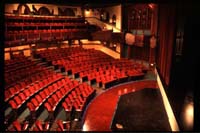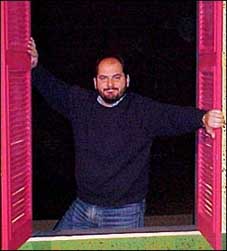|

New
English Translation Available
by Dorothy Holland & Paolo
E. Landi
Commedia
dell'arte is a heritage common to many national theater forms
(Italian as well as French, Russian and American), to cinema and to a
variety of performing methods and theories. Unfortunately, it is little
known and even less put in practice. University students and professionals
rarely get introduced to its physical energy, game, masks, and improvisations.
Visual documents of the Commedia performances are available but for texts,
we have only the scenarios that summarize the plots and contain some undecipherable
references to 'gags', and the prop lists. Those texts were meant for the
use of the actors and the company members. Goldoni's
Servant of Two Master and Venetian Twins are
very useful because they give us an insight into what might have been
a Commedia play. When Goldoni wrote them, he
was early in his playwriting career when he was working as a lawyer in
Pisa. He first gave the scenario
to a company and after some months wrote the text, basing it on the improvisations
of the actors. So this play comes from the stage to the page, and not
the contrary, as usually happens. Venetian Twins follows the tradition
of the plot about twins (Maenecmi by Plautus,
and Comedy of Errors by Shakespeare, just to mention the best known),
inserting another traditional story that of an evil character disguised
in the dress of a pious man (Moliere's Tartuffe). Staging this play, our
goal, has been that of researching the elements of the Commedia dell'arte that still survive in cinema and in contemporary
theatre such as mask, and improvisation A mask
is not only an object but it also represents a stereotypical character
who possesses some standard qualities that never change, no matter what
the plot might do. Arlecchino, Brighella, the Doctor
are wearing masks and are masks. For example in the cinema: The Little
Tramp (of Charlie Chaplin) was a mask as well. The slapstick is coming
directly from the tradition of the commedia. The commedia's
actors are famous for improvising the text. This is only partially true.
They knew monologues and dialogues that could be used in different situations.
But, from time to time, they would improvise, especially with the audience.
The audience becomes the best partner of the character - sharing his real
thoughts (using the so called ASIDE) and feelings. So, we asked ourselves:
what is the contemporary theatre that involves the audience in the action?
Our answer: standup comedy. Eduardo De Filippo
and Dario Fo (the best-known
Italian playwrights - with Pirandello- of last century), did use improvisation
in their performances. They both consider commedia as a useful tool for
creating a new theatre, going back to its root (to play - to see) in order
to involve the audience in a process of better understanding our contemporary
life. Twins is the story of two brothers, one very smart (Tonino),
the other very na´ve (Zanetto). While Goldoni is using Tonino for celebrating
the skills of the new merchant middle-class (in a period when Venice
was the New York of the
Mediterranean), Zanetto
is the sympathetic childlike character who asks, "Aren't we too well
organized, too much on our schedule? Aren't we forgetting something about
ourselves? Aren't we killing the child we have inside?" .
    
|
Venetian
Twins
by
Carlo Goldoni
Directed
by Paolo
Emilio Landi
Set
Reed West III
Costumes
Santi Migneco
Costume
Coordinator Nancy Allen
Make
Up Coordinator Leslie Pope
Fight
Choreographer Phil Hayes
Associate
TechnicaDirector Rich Mason


Read
the INTERVIEWS: Richmond.com
Style Weekly


|
![]()
![]()


